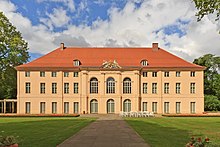| Pankow District (Berlin) | |
.jpg/250px-Rathaus_Pankow_(2009).jpg) | |
Location .svg/250px-Berlin_Bezirk_Pankow_(labeled).svg.png) | |
Coat of arms  | |
| State | Germany |
|---|---|
| Region | East Germany |
Pankow District it is the third of the 12 districts of Berlin.
To know
The most interesting neighborhood in the district is that of Prenzlauer Berg to which a separate article is dedicated.
Geographical notes
The district of Pankow occupies the northeastern part of the conurbation of Berlin. It borders to the east with the Lichtenberg district, to the south with the district of Friedrichshain, to the west with the center, the neighborhood of Wedding and the Reinickendorf district. Buch is its northernmost neighborhood and also of the whole. Berlin. It is surrounded entirely by the federal state of Brandenburg.
The district of Pankow has a different population density; 2/3 of its inhabitants are concentrated in the southern districts of Prenzlauer Berg, Pankow and Weißensee. On the other hand, the northern ones are less populated. In particular, the neighborhoods of Blankenfelde and Malchow together have less than one percent of the total population of the district.
Background
At the end of the Second World War, the Pankov district was assigned to the Soviet sector of the city as established in Yalta conference but from 1949 until 1990 it was de facto administered by the German Democratic Republic, despite this violating the agreements on the special status of Berlin and the protests of the Allies.
From 1961 Pankow found himself close to the wall erected along a section of the northern suburban railway (S-bahn). The stations, however, were on the western side, so the authorities of the German Democratic Republic closed the railway section to traffic.
With the German reunification of 3 October 1990, the district of Pankow became part of the federal state of Berlin. On September 16, 2000, the U2 underground line was extended from Vinetastraße to the Berlin-Pankow station.
How to orient yourself

How to get
How to get around
What see

_-_2015.jpg/220px-Berlin_-_Sowjetisches_Ehrenmal_(Schönholzer_Heide)_-_2015.jpg)
- 1 Schönhausen Palace (Schloss Schönhausen) (Niederschönhausen district). A baroque palace from 1662 that served as the official residence of the president of the GDR Wilhelm Pieck. After his death it was used by the GDR government to welcome official heads of state visiting East Berlin as a guest house
- 2 Monumental Cemetery of the Soviet Fallen (Sowjetisches Ehrenmal in der Schönholzer Heide). It was completed in November 1949 to a design by a team of Soviet architects of the time as the burial place of Soviet soldiers who died during the Battle of Berlin. It covers an area of 30,000 m² and is the largest of the three Soviet cemeteries in Berlin (the other two are at Treptower park and a Tiergarten). It occupies the northwestern part of the Schönholzer Heide park, which was transformed into a forced labor camp during World War II. The main avenue ends at a widening decorated with a 33.5 m high obelisk. and a statue on a porphyry base depicting mother earth.
- 3 Former town hall (Rathaus Pankow), Breite Straße 24a-26 (near the Wollankstraße S-Bahn station). The original building was built in 1901-1903 to designs by Wilhelm Johow in a mixture of various architectural styles typical of the early 20th century, such as Neo-Gothic, Neo-Baroque and Art Nouveau elements. Its exterior is characterized by the use of red bricks.
- 4 Blankenfelde-Pankow Botanical Garden. It is home to around 6000 plant species.
- 5 Bürgerpark Pankow.
- 6 Weißensee Jewish cemetery (Jüdischer Friedhof Berlin-Weißensee), Herbert-Baum-Straße 45.
What to do

- 1 [link previously not working]Weißensee bathhouse (Strandbad Weißensee), Berliner Allee 155. Bathing establishment in operation since 1912. The White Lake (Weißer See) (lit.) is located within the park of the same name and reaches a depth of 4 m. A cycle path winds through the park. There is also the possibility to rent boats.
- 2 Sommer bad Pankow, Wolfshagener Straße 91-93, ☎ 49 30-4749720.
 June August Mon-Sun 08: 00-20: 00. Outdoor swimming pool with slides operating only in the summer months.
June August Mon-Sun 08: 00-20: 00. Outdoor swimming pool with slides operating only in the summer months.
Shopping
How to have fun

- 1 Brotfabrik, Caligariplatz 1. A cultural center set up in a former bakery from 1914. It is made up of several exhibition rooms and a cinema where films from the centre's archives are shown. It also has a nice bar (kneipe) with snacks.
Where to eat
Moderate prices
- 1 Schiller Burger, Berliner Allee 96, ☎ 49 30 68815802.
 Mon-Sun 11: 30-21: 00.
Mon-Sun 11: 30-21: 00. - 2 Zum Nudelholz, Falkenberger Str. 37 A, ☎ 49 30 925 2507.
 Sat-Sun 12: 00-00: 00.
Sat-Sun 12: 00-00: 00. - 3 Konnopke's Imbiß, Mahlerstr. 3, ☎ 49 30 9252576. Hausgemachte Eintöpfe. Original Berliner Currywurst. - in der Tradition von Konnopke. Goldgelb gebraten in Schweineschmalz mit hausgemachter Sauce.
Where stay
How to keep in touch
Other projects
 Wikipedia contains an entry concerning Pankow District
Wikipedia contains an entry concerning Pankow District Commons contains images or other files on Pankow District
Commons contains images or other files on Pankow District
